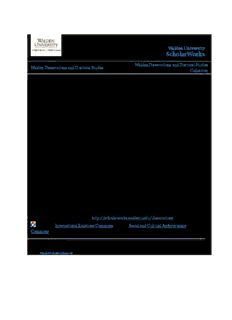
Rapport Development and Native Language Use Between US Advisors and Afghan Counterparts PDF
Preview Rapport Development and Native Language Use Between US Advisors and Afghan Counterparts
Walden University ScholarWorks Walden Dissertations and Doctoral Studies Walden Dissertations and Doctoral Studies Collection 2017 Rapport Development and Native Language Use Between U.S. Advisors and Afghan Counterparts Sean Ryan Ryan Walden University Follow this and additional works at:https://scholarworks.waldenu.edu/dissertations Part of theInternational Relations Commons, and theSocial and Cultural Anthropology Commons This Dissertation is brought to you for free and open access by the Walden Dissertations and Doctoral Studies Collection at ScholarWorks. It has been accepted for inclusion in Walden Dissertations and Doctoral Studies by an authorized administrator of ScholarWorks. For more information, please [email protected]. Walden University College of Management and Technology This is to certify that the doctoral dissertation by Sean Ryan has been found to be complete and satisfactory in all respects, and that any and all revisions required by the review committee have been made. Review Committee Dr. Richard Schuttler, Committee Chairperson, Management Faculty Dr. Karla Phlypo, Committee Member, Management Faculty Dr. David Banner, University Reviewer, Management Faculty Chief Academic Officer Eric Riedel, Ph.D. Walden University 2017 Abstract Rapport Development and Native Language Use Between U.S. Advisors and Afghan Counterparts by Sean Ryan MS, U.S. Army War College, 2006 MA, Touro University, 2003 BS, United States Military Academy, 1982 Dissertation Submitted in Partial Fulfillment of the Requirements for the Degree of Doctor of Philosophy Management Walden University May 2017 Abstract Advisory activities form a central element of the U.S. National Security Strategy to mitigate the need for employment of large military formations. The commitment of large U.S. combat formations has resulted in more than 6,000 fatalities since September 11, 2001; poor relationship skills were cited as contributing factors in 51 or more fratricide- murders of U.S. soldiers by Afghan compatriots in 2012. Informed by social exchange theory, servant leadership theory, and role theory, the Army conceptual rapport framework provided a lens for this phenomenological symbolic interactionism study of rapport between Afghan counterparts and U.S. advisors. Participants included 15 English-speaking Afghan soldiers, police, and government officials. Data from semi- structured interviews conducted via Internet or telephone were manually coded and analyzed for overarching themes. Findings indicated that mutual understanding and respect were principal components to building rapport, and rudimentary use of Afghan languages by U.S. advisors provided symbolic value that contributed to rapport development. Findings may contribute to positive social change by informing advisor employment policies, enhancing preparatory training, and improving relationships between U.S. advisors and the foreign leaders with whom they work. Rapport Development and Native Language Use Between U.S. Advisors and Afghan Counterparts by Sean Ryan MS, U.S. Army War College, 2006 MA, Touro University, 2003 BS, United States Military Academy, 1982 Dissertation Submitted in Partial Fulfillment of the Requirements for the Degree of Doctor of Philosophy Management Walden University May 2017 Dedication This study is dedicated to my father, John J. Ryan, Jr., a man who cherished lifelong learning. Acknowledgments I wish to thank my family, friends, and colleagues for unwavering support throughout this doctoral journey. Special thanks go to my wife, Lei, for her patience, support, and understanding for the countless hours that were spent on academics, research, and writing this study. My sister, Maureen, and brother, Lou, were steady and consistent in their support and encouragement. My dissertation committee, Drs. Rich Schuttler and Karla Phlypo, provided inspiration, encouragement, and critical guidance throughout the process of scoping, drafting, and completing this dissertation. Drs. Lester Grau, Anna Simons, and Andrea Dew, friends and colleagues for many years, not only provided insights and encouragement, but also stepped up when asked to support my field study. Dr. Lilburn Hoehn, an inspiration and mentor, always answered my calls, provided his perspectives and experience as the idea for this study developed, and also offered his assistance supporting my field test. Dr. Michelle Preiksaitis and Professor Joyce Busch gave freely of their time encouraging and helping me to press on and finish. My good friends and colleagues, Major General (Retired) Richard Sherlock, Brigadier General (Retired) Richard Mills, Warrant Officer Joe Rudolf, and Master Sergeant (Retired) Andy Lord remained loyal and supportive friends throughout this journey just as they did throughout numerous deployments, operations, and assignments that ranged from classrooms to combat. Last, but not least, I must acknowledge the courageous Afghans who spent time sharing their experiences and perspectives with me. Their dedication to improving the conditions in Afghanistan was inspiring. Their contributions made this research possible. Table of Contents List of Tables .......................................................................................................................v List of Figures .................................................................................................................... vi Chapter 1: Introduction to the Study ....................................................................................1 Background of the Study ...............................................................................................2 Problem Statement .........................................................................................................8 Purpose of the Study ......................................................................................................9 Research Questions ......................................................................................................10 Theoretical Foundation ................................................................................................10 Conceptual Framework ................................................................................................12 Nature of the Study ......................................................................................................12 Definitions....................................................................................................................14 Assumptions .................................................................................................................15 Scope and Delimitations ..............................................................................................15 Limitations ...................................................................................................................16 Significance of the Study .............................................................................................17 Significance to Practice......................................................................................... 17 Significance to Theory .......................................................................................... 18 Significance to Social Change .............................................................................. 18 Summary and Transition ..............................................................................................19 Chapter 2: Literature Review .............................................................................................21 Literature Search Strategy............................................................................................24 i Theoretical Foundation ................................................................................................27 Conceptual Framework ................................................................................................35 Literature Review.........................................................................................................39 Historical Background .......................................................................................... 39 Contemporary Research ........................................................................................ 44 Summary and Conclusions ..........................................................................................67 Chapter 3: Research Method ..............................................................................................71 Research Design and Rationale ...................................................................................72 Role of the Researcher .................................................................................................75 Methodology ................................................................................................................76 Participant Selection Logic ................................................................................... 87 Instrumentation ..................................................................................................... 89 Pilot Study ............................................................................................................. 91 Procedures for Recruitment, Participation, and Data Collection .......................... 92 Data Analysis Plan ................................................................................................ 95 Issues of Trustworthiness ...........................................................................................101 Credibility ........................................................................................................... 101 Transferability ..................................................................................................... 102 Dependability ...................................................................................................... 103 Confirmability ..................................................................................................... 103 Ethical Procedures .............................................................................................. 104 Summary ....................................................................................................................106 ii Chapter 4: Results ............................................................................................................107 Pilot Study ..................................................................................................................109 Research Setting.........................................................................................................111 Demographics ............................................................................................................112 Data Collection ..........................................................................................................113 Data Analysis .............................................................................................................116 Evidence of Trustworthiness......................................................................................118 Credibility ........................................................................................................... 118 Transferability ..................................................................................................... 119 Dependability ...................................................................................................... 120 Confirmability ..................................................................................................... 121 Study Results .............................................................................................................121 Thematic outcomes ..........................................................................................................122 Summary ....................................................................................................................133 Chapter 5: Discussion, Conclusions, and Recommendations ..........................................135 Interpretation of Findings ..........................................................................................136 Limitations of the Study.............................................................................................143 Recommendations ......................................................................................................144 Implications................................................................................................................147 Conclusions ................................................................................................................151 References ........................................................................................................................153 Appendix A: Interview Protocol ......................................................................................166 iii
Description: